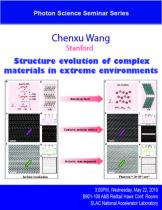Speaker: Chenxu Wang, Stanford
Program Description:
Structural materials play an important role in the operation of nuclear reactors, wherein materials are likely to experience extreme conditions, such as severe radiation damage, high temperature, and high pressure. Advanced materials can improve economics and safety of next generation reactors. Mn+1AXn phases and high-entropy alloys (HEAs) both possess unique properties, making them promising candidate materials for advanced nuclear systems.
In this talk, I will present the direct observation of irradiation-induced antisite defects in Mn+1AXn phases and chemical disordering using high-resolution (HR) aberration-corrected STEM HAADF and ABF imaging. An order-to-disorder, hex-to-γ-to-fcc phase transformation and the formation of metastable solid solution phases were observed using synchrotron grazing incidence X-ray diffraction (GIXRD), atom probe tomography (APT), and first-principle calculations. Role of M, A, X, and n factors in radiation tolerance of Mn+1AXn phases will be discussed. I will also introduce processing tools (ion irradiation and high pressure) that can uniquely tailor materials’ structures and produce new phases (fcc-MAX solid solutions and hcp-HEAs).





